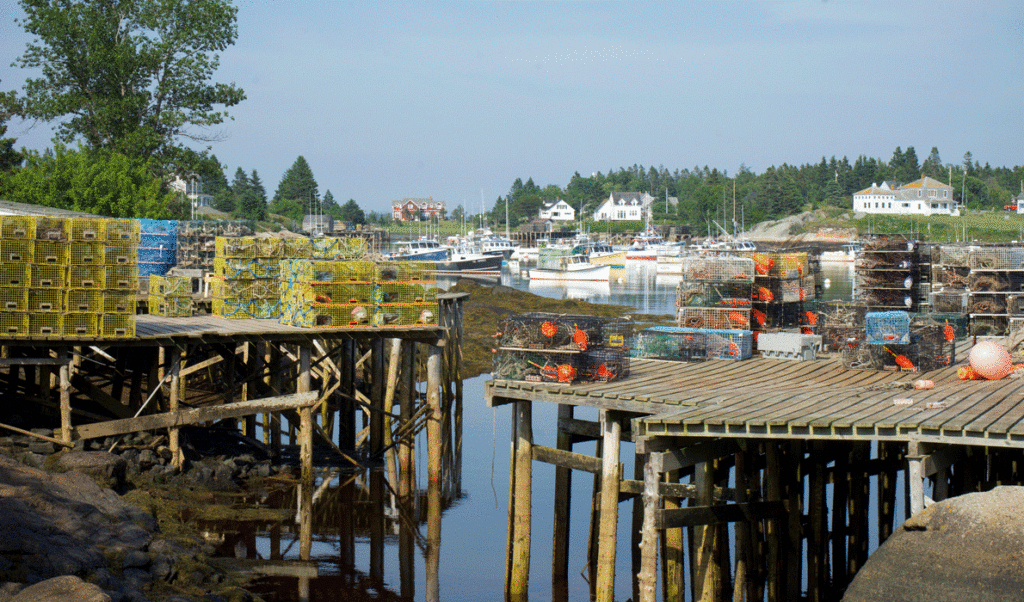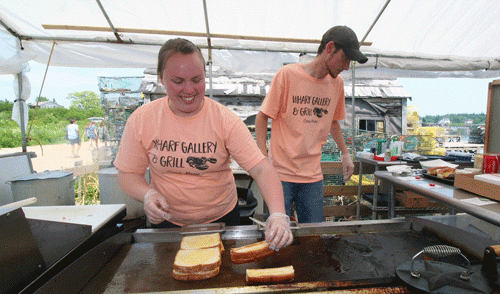
LAURIE SCHREIBER
The crew prepares food at Joe Young’s Wharf Grill & Gallery.
The tiny fishing village of Corea is easily missed by those traveling on the Schoodic Peninsula.
Part of the larger town of Gouldsboro, it’s several miles from the peninsula’s portion of Acadia National Park, a hub of tourist activity. It takes thought to jaunt further east, toward a separate protrusion of land and down rustic Route 195—through heaths frequented by wading birds and surrounded by stunted jack pine, past a giant osprey nest atop a telephone pole—to the sea, where Corea exists in something of a time capsule, preserved by the salty breeze.
The village is a puzzle of ribbony lanes lined by well-tended cedar-shingle homes, many offered as overnight lodgings or rentals to folks who do find their way here. Otherwise, there are only a few businesses, like Bartlett House Quilts. Carmen Weeks, an educator from Newtown, Conn., who retired to Corea nearly 20 years ago, now makes vibrantly colorful quilts which she sells from her home. She found out about the village through a radio program about little-known getaways.
“I came here with my husband on vacation and said, ‘This is the place,’” she recalled. “I love it. It’s like heaven on earth.”
Even though Acadia is bringing more tourists to the peninsula, she said, Corea hasn’t changed much over the years.
“This is a working waterfront,” said Weeks. “That’s what Corea is and that’s why I came here. There are no big sailboats coming in here.”
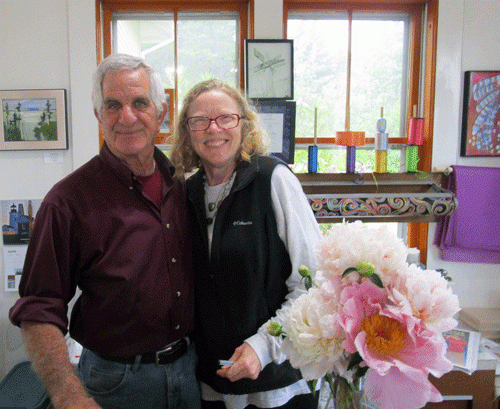
LAURIE SCHREIBER
Gary and Rosemary Levin of Chapter Two.
Rosemary Levin who, with her husband Garry, runs a collectibles and artisan shop in the village called Chapter Two, echoes that sentiment.
“It’s still kind of stuck in the ‘50s,” she said. “It’s very quiet. There’s a big lunch rush at Joe’s, but once that’s done, it’s a sleepy little village.”
THE REAL MAINE
By “Joe’s,” she means Joe Young’s Wharf Grill & Gallery, located another few seconds down the road. On a recent hot June day, it was the source of a quiet murmur, absorbed by a whispering sea breeze, of lunchtime cooking and the conversation of customers sitting at picnic tables and chowing down tasty dishes like lobster rolls and farmed oysters. The harbor was full of lobsterboats gleaming in the golden sun, its shore lined with fishing wharfs piled with traps and coils of colorful rope.
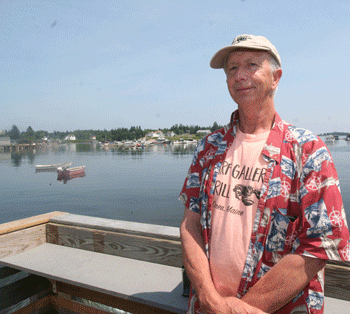
LAURIE SCHREIBER
Joe Young
People arrive here all kinds of ways. Locals stop in. Campers come from the Schoodic campground. B&B owners send guests. Folks staying in Bar Harbor make the trek.
“A few people stumble in,” said Young, known for his story-telling ways. “I had a couple and their kids a few years ago. They were in their motor home and staying at a campground on MDI. They ended up over here for the day. The walked down the lane and the dad looks out to the harbor and turns back to his wife and hollers, ‘Honey, I think we found the real Maine!’”
Young’s family has been in Corea since 1812. His wharf features a rusted kettle and a sign that explains it was used to render cod livers for oil, back when cod was king.
As a kid, he lived in Calais, where his father worked for a paper company and lobstered on the side. The family spent weekends and vacations in Corea. In 1977, Young was in his 20s and his life was adrift. He moved to Corea, started clamming with a friend, worked his way into lobster fishing, and stuck around.
He started his restaurant and gallery by accident. His aunt was Louise Z. Young, a Massachusetts photographer who left her collection of negatives to Young when she died in 2004. The collection depicted life in the 1940s through 1960s in Down East Maine. Young printed a selection and converted the workshop on his wharf into a little gallery. That was in 2009. Hardly anyone came.
“So my wife said, ‘If you want people to come and look at the photos and maybe buy them, get a hotdog cart,’” he said.
So he installed a hotdog cart and a couple of tables as a tourist draw. But without set hours, there still were few visitors.
“I said, ‘We either are open every day and have set hours, or we’re all done,’” he said.
In 2013, he reopened with a separate lobster shack and more tables, and has added on since then.
Around the same time, he took an aquaculture course and started a little oyster farm. He’s waiting now for state approval for a three-acre lease.
“I had never eaten an oyster,” he said. “It just sounded like fun to try. A couple of years ago, I went to a neighbor who spent a lot of time in the Chesapeake. I said, ‘Can you show me how to get into this oyster?’ She pops it open. I’m not an adventurous eater. I looked at that oyster and said, ‘You’re going to put that in your mouth?’ She slurped it down. So I opened one and felt, ‘There’s no backing down.’ I was amazed at how delicious it was.”
Young’s grandparents, Katie and Forrest Young, had a restaurant in the 1930s to the early 1950s.
“It was quite a summer colony back then—writers, artists, rusticators would come here and spend the summer and eat at my grandmother’s restaurant,” he said. “They all knew each other and there was lot of camaraderie.”
In a way, things haven’t changed much.
“It has, but it hasn’t,” he said. “It’s still all lobsterboats. We all have our own wharfs. The houses around the harbor—fishermen don’t live in them and out-of-staters have them, but they’ve been kept pretty much the same. It’s still a fishing community. You’re sitting out on the wharf and looking at the boats, and it’s kind of neat.”
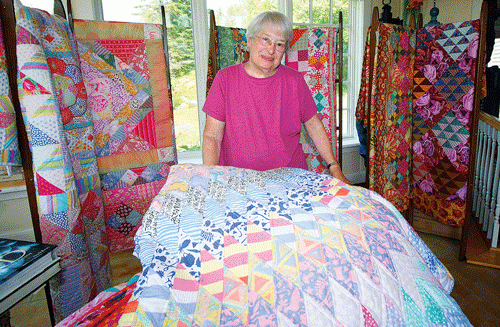
LAURIE SCHREIBER
Carmen Weeks with some of the quilts she sells in Corea village.
